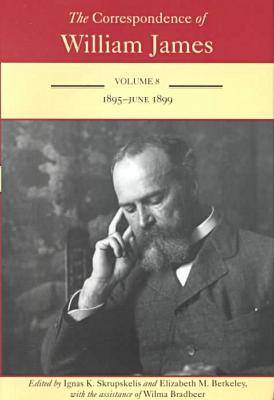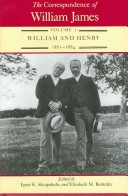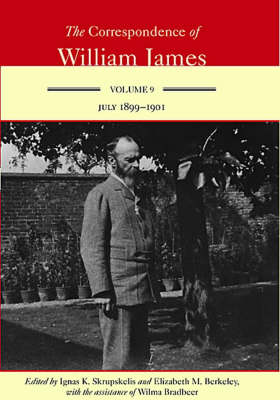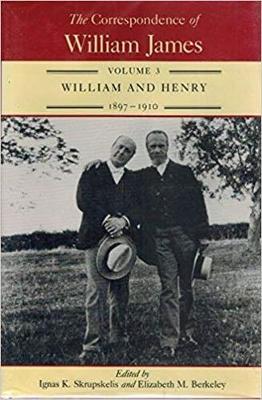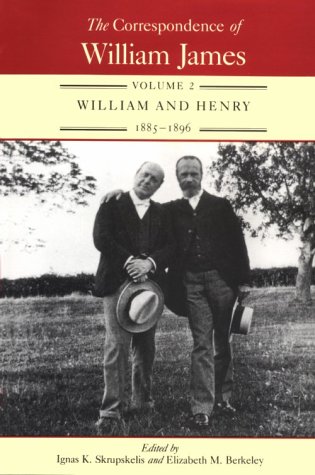The Correspondence of William James
6 total works
The Correspondence of William James v. 8; 1895-June 1899
by William James
This eighth volume of a projected twelve continues the series of William James's correspondence with family, friends, and colleagues, which was begun in volume 4 of the Correspondence. The eight volume contains some 530 letters, with an additional 620 letters calendared, thus giving a complete accounting of James's known correspondence from 1895 to June 1899 inclusive.
During this period, James struggles against various temptations, never completely successfully, to devote all of his attention to philosophy, the first and great love of his life. To this end, he published The Will to Believe with a promise to set out more formally his system of radical empiricism. The volume helps document the reception of the book and the controversy to which the title essay gave rise, a controversy the main issues of which have once again returned to the forefront of philosophical discussion and places James in the middle of postmodernist discussion. His 1898 tour of California where he delivered his lecture on "Philosophical Conceptions and Practical Results," the start of the pragmatism controversy, also belongs to the period of the present volume. Among the distractions from philosophy are his 1896 Lowell Institute lectures on exceptional mental states and the Gifford lectures on varieties of religious experience, on which he began work in the late 1890s. His new philosophical correspondents are the Polish nationalist and messianist Wincenty Lutoslawski and Ferdinand Canning Scott Schiller, the future strategist of the pragmatism controversy.
James becomes a public philosopher, whose views were sought on the problems of the day. To James's great dismay, the United States was becoming an imperial power: the Venezuela crisis and the Spanish-American War sometimes rousing James into outrage. France was being torn apart by the Dreyfus affair with James expressing strong sympathies for Dreyfus and the intellectuals. The race question was coming to the forefront, with Booker T. Washington entering the list of correspondents.
His family continued to take up much of his attention. As his children grew older, they became the recipients of numerous didactic, affectionate, and playful letters from a father often at a distance.
Vol 1
This definitive, fully annotated 12-volume collection of The Correspondence of William James reproduces the majority of known letters to and from James in their entirety, while the remainder are "calendared" with brief summaries. Edited by Ignas K. Skrupskelis and Elizabeth M. Berkeley, these volumes are extraordinarily valuable for James scholars and a source of considerable enjoyment and insight for others.
This volume begins a new series: William James's correspondence with family, friends, and colleagues, starting when William James was fourteen and on his second trip abroad and concluding when he was thirty-five, negotiating with the president of Johns Hopkins University about a course he had been invited to teach on the relation between mind and body. These letters deal with everything from his protracted search for a vocation, his recurrent physical and emotional problems, his irregular education, his odd -- one might say Jamesian -- courtship of Alice Howe Gibbens, and his developing views on art, morality, politics, women, medicine, philosophy, science, religion, national character, the Civil War, the South, Americans abroad, and other writers and thinkers. They are witness to his growth into adulthood and the price he paid for that growth. William James's teenage letters reveal an adolescent amazingly charming and precocious who displayed from the beginning the promise of his maturity: witty, self-assured, and discerning.
This ninth volume of a projected twelve continues the series of William James's correspondence with family, friends, and colleagues that was begun in Volume 4. Consisting of some 470 letters, with as many more calendared, it offers a complete accounting of James's known correspondence from July 1899 through 1901.
Volume 9 covers the period of James's great collapse, of his years of exile in Europe in search of health, and of the beginning of his withdrawal from full-time teaching at Harvard. In spite of his heart troubles, nervous prostration, and often-proclaimed inability to work, James wrote and successfully delivered his Gifford Lectures, which in 1902 were published as The Varieties of Religious Experience, probably his most widely read work.
In Europe, James develops a profound ambivalence toward America. He comes to realize how strong his attachment is to his home but at the same time he becomes more and more dismayed by the emergence of the United States as an imperial power with the consequent loss of what he perceives to be his country's moral purity.
James's views on religion are expressed in various fragments and asides. While creeds and churches continue to make no claims upon him, he believes that religious experience places us in touch with a deeper stratum of reality. Because of his intimate association during these months with the dying Frederic Myers, problems of psychical research are also prominent.
He corresponds with leading women in the emerging field of social work, including Frances Morse, Elizabeth Evans, and the Goldmark sisters, Pauline and Susan, and prominent intellectuals such as Theodore Flournoy, Wincenty Lutoslawski, Carl Stumpf, Ferdinand Schiller, Henry Sidgwick, Hugo Munsterberg, Josiah Royce, George Herbert Palmer, Charles William Eliot, James Mark Baldwin, and Edwin Godkin. His daughter, Margaret Mary, and his youngest son, Alexander Robertson, receive fatherly advice and encouragement from a distance during the crucial years of their young lives.
